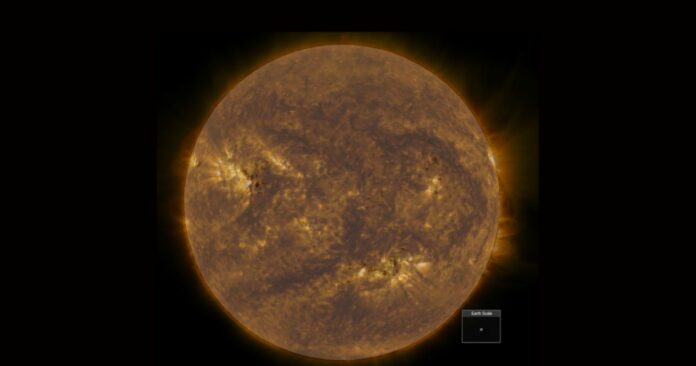The solar corona is two to three orders of magnitude hotter than the underlying photosphere, and the energy loss of coronal plasma is extreme. Using the 1.6 m Goode Solar Telescope, an international team of scientists has a new answer to the question — commonly called the Sun’s coronal heating problem.
A relatively cool, dark, and strongly magnetized plasma area on the Sun is the source of powerful wave energy that can travel through the solar atmosphere and maintain temperatures of one million degrees Kelvin inside the corona.
One of the major puzzles in solar physics study is the coronal heating problem. It has been around for almost a century. Thanks to this study, we now have brand-new insights into this problem, which may be essential for clarifying several puzzling issues regarding energy dissipation, movement in the solar atmosphere, and the nature of space weather.
According to researchers, the discovery is the most recent clue to solving a number of linked puzzles involving Earth’s nearest star.
The team led by Yuan Ding initially captured transverse oscillations in the sunspot umbra, the darkest and coldest zone of the Sun, using GST’s special imaging capabilities.
These dark sunspot patches can develop due to the star’s strong magnetic field, which prevents thermal conduction and limits energy flow from the hotter center to the visible surface (or photosphere), where temperatures can reach about 5,000 degrees Celsius.
The team measured oscillatory transverse motions of plasma fibrils within the sunspot umbra, where the magnetic field is more than 6,000 times stronger than that of Earth, as well as activity related to numerous dark features found in an active sunspot recorded on July 14, 2015, by BBSO’s GST.
Fibrils are cone-shaped constructions with an average width of 100 km and height of 500–1,000 km. They have a lifespan of two to three minutes, and because magnetic fields are highest in the deepest regions of the umbra, they frequently resurface there.
Wenda Cao, BBSO director and NJIT physics professor who is co-author of the study, said, “These dark dynamic fibrils had been observed in the sunspot umbra for a long time, but for the first time, our team was able to detect their lateral oscillations that are manifestations of fast waves. These persistent and ubiquitous transverse waves in strongly magnetized fibrils bring energy upwards through vertically elongated magnetic conduits and contribute to the heating of the Sun’s upper atmosphere.”
The team calculated the energy carried by these waves through a numerical simulation. They believe it could be up to thousands of times stronger than energy losses in the active region plasma of the Sun’s upper atmosphere — dissipating energy up to four orders of magnitude stronger than the heating rate required to maintain the scorching plasma temperatures in the corona.
Vasyl Yurchyshyn, NJIT-CSTR research professor of heliophysics and BBSO senior scientist, said, “Various waves have been detected everywhere on the Sun, but typically their energy is too low to heat the corona. The fast waves detected in the sunspot umbra are a persistent and efficient energy source that may be responsible for heating the corona above sunspots.”
Scientists noted, “The new findings not only revolutionize our view of the sunspot umbra but offer another important step in advancing physicists’ understanding of the energy transport processes and heating of the solar corona.”
Cao said, “While these findings are a step forward toward solving the mystery, the energy flux coming out of sunspots may be only responsible for heating those loops that are rooted in sunspots. Meanwhile, there are other sunspot-free regions associated with hot coronal loops that still await to be explained. We expect that GST/BBSO will continue providing the highest-resolution observational evidence to unlock mysteries of our star further.”
Journal Reference:
- Yuan, D., Fu, L., Cao, W. et al. Transverse oscillations and an energy source in a strongly magnetized sunspot. Nature Astronomy (2023). DOI: 10.1038/s41550-023-01973-3
